You ran your internet browser such as Chrome, FF, Internet Explorer and Edge, but somehow, for some reason, you didn’t get your favorite start page you wanted after running it. This is sign of browser hijacker infection, potentially unwanted program made to redirect your internet browser to Local Weather Radar web-page. The Local Weather Radar hijacker changing the internet browsers settings such as homepage, new tab and default search provider with its own data. If you would like to remove this browser hijacker and are unable to do so, you can use the steps below to detect and remove Local Weather Radar and any other unwanted software for free.
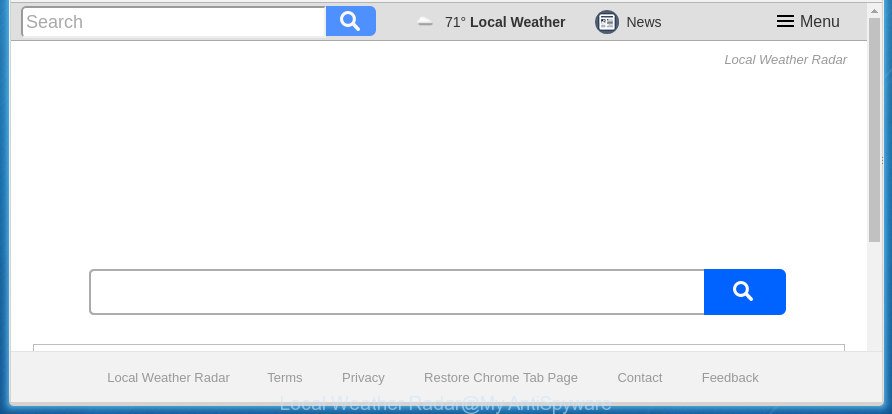
The Local Weather Radar browser hijacker may also change the default search engine that will virtually block the possibility of finding information on the Internet. The reason for this is that the Local Weather Radar search results can display a lot of advertisements, links to unwanted and ad web sites. Only the remaining part is the result of your search request, loaded from the major search providers such as Google, Yahoo or Bing.
Also, ‘ad-supported’ software (also known as adware) can be installed on the system together with Local Weather Radar browser hijacker. It will insert lots of advertisements directly to the web-pages that you view, creating a sense that advertisements has been added by the authors of the page. Moreover, legal ads can be replaced on fake advertisements that will offer to download and install various unnecessary and harmful applications. Moreover, the Local Weather Radar hijacker has the ability to gather lots of personal info which can be later used for marketing purposes.
In addition to that, as was mentioned earlier, some browser hijackers like Local Weather Radar to also modify all browsers shortcuts that located on your Desktop or Start menu. So, every infected shortcut will try to redirect your web-browser to undesired web-pages, certain of which might be harmful. It can make the whole system more vulnerable to hacker attacks.
Therefore it’s very important to clean your computer of browser hijacker as soon as possible. Follow the instructions below to get rid of Local Weather Radar home page, as well as other malware and ad-supported software, which may be installed onto your PC system along with it.
Remove Local Weather Radar (removal instructions)
Without a doubt, the browser hijacker is harmful to your personal computer. So you need to quickly and completely get rid of this malicious software. To delete this browser hijacker infection, you may use the manual removal steps which are given below or free malicious software removal utility such as Zemana Anti-Malware, Malwarebytes or AdwCleaner (all are free). We suggest you use automatic removal solution that will help you to get rid of Local Weather Radar search easily and safely. Manual removal is best used only if you’re well versed in PC system or in the case where hijacker is not removed automatically. Some of the steps will require you to reboot your machine or exit this page. So, read this guidance carefully, then bookmark or print it for later reference.
How to remove Local Weather Radar without any software
The following instructions is a step-by-step guide, which will help you manually remove Local Weather Radar start page from the Google Chrome, Firefox, MS Edge and Internet Explorer.
Removing the Local Weather Radar, check the list of installed software first
First of all, check the list of installed software on your system and remove all unknown and recently installed software. If you see an unknown program with incorrect spelling or varying capital letters, it have most likely been installed by malware and you should clean it off first with malware removal tool such as Zemana Anti-malware.
Press Windows button ![]() , then click Search
, then click Search ![]() . Type “Control panel”and press Enter. If you using Windows XP or Windows 7, then press “Start” and select “Control Panel”. It will show the Windows Control Panel like below.
. Type “Control panel”and press Enter. If you using Windows XP or Windows 7, then press “Start” and select “Control Panel”. It will show the Windows Control Panel like below.

Further, press “Uninstall a program” ![]()
It will show a list of all applications installed on your computer. Scroll through the all list, and uninstall any suspicious and unknown software.
Disinfect the web-browser’s shortcuts to remove Local Weather Radar
Once installed, this browser hijacker infection may add an argument such as “http://site.address” into the Target property of the desktop shortcut for the Chrome, Internet Explorer, FF and Edge. Due to this, every time you launch the browser, it will open the intrusive start page.
Right click to a desktop shortcut for your browser. Choose the “Properties” option. It will open the Properties window. Select the “Shortcut” tab here, after that, look at the “Target” field. The browser hijacker can change it. If you are seeing something like “…exe http://site.address” then you need to remove “http…” and leave only, depending on the browser you are using:
- Google Chrome: chrome.exe
- Opera: opera.exe
- Firefox: firefox.exe
- Internet Explorer: iexplore.exe
Look at the example as displayed below.

Once is done, click the “OK” button to save the changes. Please repeat this step for web browser shortcuts which redirects to an undesired sites. When you have completed, go to next step.
Get rid of Local Weather Radar redirect from Chrome
If your Chrome browser is redirected to intrusive Local Weather Radar page, it may be necessary to completely reset your web-browser program to its default settings.

- First start the Google Chrome and press Menu button (small button in the form of three horizontal stripes).
- It will show the Chrome main menu. Select “Settings” option.
- You will see the Google Chrome’s settings page. Scroll down and press “Show advanced settings” link.
- Scroll down again and click the “Reset settings” button.
- The Chrome will display the reset profile settings page as on the image above.
- Next click the “Reset” button.
- Once this procedure is finished, your internet browser’s new tab page, home page and search provider by default will be restored to their original defaults.
- To learn more, read the blog post How to reset Chrome settings to default.
Delete Local Weather Radar search from Internet Explorer
By resetting Internet Explorer browser you restore your web browser settings to its default state. This is good initial when troubleshooting problems that might have been caused by hijacker like Local Weather Radar.
First, start the IE. Next, click the button in the form of gear (![]() ). It will open the Tools drop-down menu, click the “Internet Options” as on the image below.
). It will open the Tools drop-down menu, click the “Internet Options” as on the image below.

In the “Internet Options” window click on the Advanced tab, then click the Reset button. The Internet Explorer will show the “Reset Internet Explorer settings” window as displayed on the image below. Select the “Delete personal settings” check box, then click “Reset” button.

You will now need to reboot your computer for the changes to take effect.
Remove Local Weather Radar from Firefox by resetting internet browser settings
If the Firefox browser program is hijacked, then resetting its settings can help. The Reset feature is available on all modern version of FF. A reset can fix many issues by restoring Firefox settings like startpage, newtab and default search provider to its default state. It’ll save your personal information such as saved passwords, bookmarks, and open tabs.
Click the Menu button (looks like three horizontal lines), and press the blue Help icon located at the bottom of the drop down menu as displayed on the screen below.

A small menu will appear, click the “Troubleshooting Information”. On this page, press “Refresh Firefox” button as displayed on the screen below.

Follow the onscreen procedure to return your FF internet browser settings to its original state.
Scan your computer and remove Local Weather Radar with free tools
Manual removal steps does not always help to completely remove the browser hijacker, as it is not easy to identify and remove components of hijacker infection and all malicious files from hard disk. Therefore, it is recommended that you use malicious software removal tool to completely remove Local Weather Radar off your personal computer. Several free malware removal tools are currently available that can be used against the browser hijacker. The optimum solution would be to run Zemana Anti Malware, Malwarebytes Free and AdwCleaner.
Scan and free your PC of Local Weather Radar with Zemana
We recommend using the Zemana AntiMalware (ZAM) that are completely clean your system of the browser hijacker. The utility is an advanced malicious software removal program created by (c) Zemana lab. It’s able to help you delete PUPs, hijacker infections, adware, malicious software, toolbars, ransomware and other security threats from your computer for free.
Download Zemana Free by clicking on the link below. Save it on your Desktop.
164813 downloads
Author: Zemana Ltd
Category: Security tools
Update: July 16, 2019
When downloading is done, close all software and windows on your system. Double-click the set up file named Zemana.AntiMalware.Setup. If the “User Account Control” dialog box pops up as on the image below, click the “Yes” button.

It will open the “Setup wizard” that will help you set up Zemana Free on your personal computer. Follow the prompts and do not make any changes to default settings.

Once install is finished successfully, Zemana Anti-Malware (ZAM) will automatically start and you can see its main screen as on the image below.

Now click the “Scan” button . Zemana tool will begin scanning the whole system to find out hijacker that created to redirect your browser to the Local Weather Radar page. A scan can take anywhere from 10 to 30 minutes, depending on the number of files on your computer and the speed of your system. When a malware, ‘ad supported’ software or PUPs are detected, the number of the security threats will change accordingly. Wait until the the checking is finished.

After Zemana Anti-Malware (ZAM) completes the scan, Zemana Anti-Malware (ZAM) will display a list of all items found by the scan. Review the results once the tool has complete the system scan. If you think an entry should not be quarantined, then uncheck it. Otherwise, simply click “Next” button. The Zemana Anti Malware (ZAM) will remove hijacker infection which alters web-browser settings to replace your home page, new tab page and default search provider with Local Weather Radar web page and move items to the program’s quarantine. Once that process is finished, you may be prompted to restart the computer.
Run Malwarebytes to delete Local Weather Radar redirect
Get rid of Local Weather Radar hijacker manually is difficult and often the browser hijacker is not completely removed. Therefore, we suggest you to run the Malwarebytes Free that are completely clean your system. Moreover, the free application will allow you to remove malicious software, PUPs, toolbars and ad supported software that your computer may be infected too.
Download MalwareBytes Anti-Malware by clicking on the following link and save it to your Desktop.
327070 downloads
Author: Malwarebytes
Category: Security tools
Update: April 15, 2020
After the download is finished, close all windows on your machine. Further, start the file named mb3-setup. If the “User Account Control” prompt pops up as on the image below, click the “Yes” button.

It will display the “Setup wizard” that will help you setup MalwareBytes Anti-Malware on the system. Follow the prompts and do not make any changes to default settings.

Once install is finished successfully, press Finish button. Then MalwareBytes Free will automatically start and you can see its main window as shown on the image below.
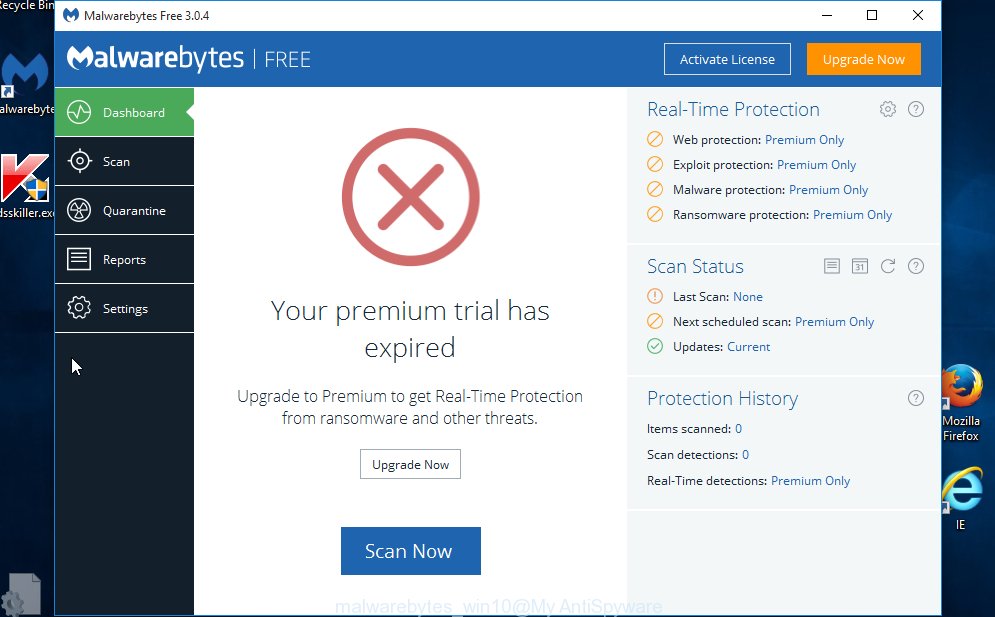
Next, click the “Scan Now” button to perform a system scan with this utility for the hijacker infection that cause a redirect to Local Weather Radar web site. A system scan can take anywhere from 5 to 30 minutes, depending on your machine. When a threat is found, the number of the security threats will change accordingly. Wait until the the checking is complete.
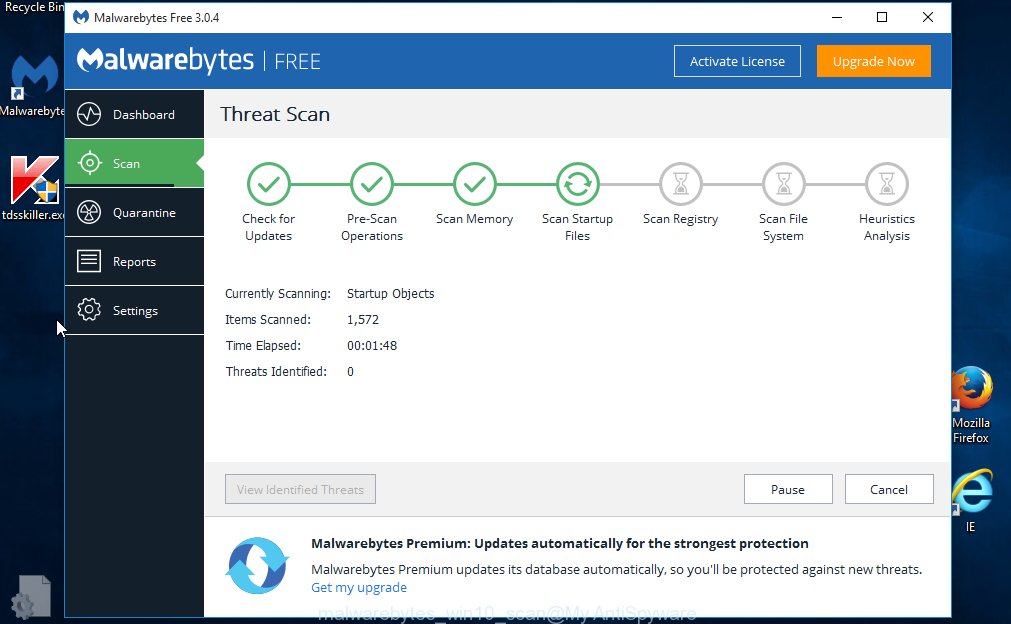
When the system scan is complete, MalwareBytes will show you the results. Review the results once the utility has finished the system scan. If you think an entry should not be quarantined, then uncheck it. Otherwise, simply press “Quarantine Selected” button.

The MalwareBytes will remove hijacker infection that alters browser settings to replace your home page, newtab page and search engine by default with Local Weather Radar web-site and move threats to the program’s quarantine. When that process is done, you can be prompted to restart your machine. We recommend you look at the following video, which completely explains the process of using the MalwareBytes Free to remove browser hijackers, ad supported software and other malware.
Get rid of Local Weather Radar hijacker and malicious extensions with AdwCleaner
AdwCleaner is a free removal utility which can scan your personal computer for a wide range of security threats like adware, malicious software, PUPs as well as hijacker which reroutes your browser to unwanted Local Weather Radar web-site. It will perform a deep scan of your computer including hard drives and Microsoft Windows registry. After a malware is detected, it will help you to remove all found threats from your PC with a simple click.
Download AdwCleaner on your MS Windows Desktop by clicking on the link below.
225545 downloads
Version: 8.4.1
Author: Xplode, MalwareBytes
Category: Security tools
Update: October 5, 2024
Once the download is finished, open the file location. You will see an icon like below.
![]()
Double click the AdwCleaner desktop icon. After the utility is launched, you will see a screen like below.
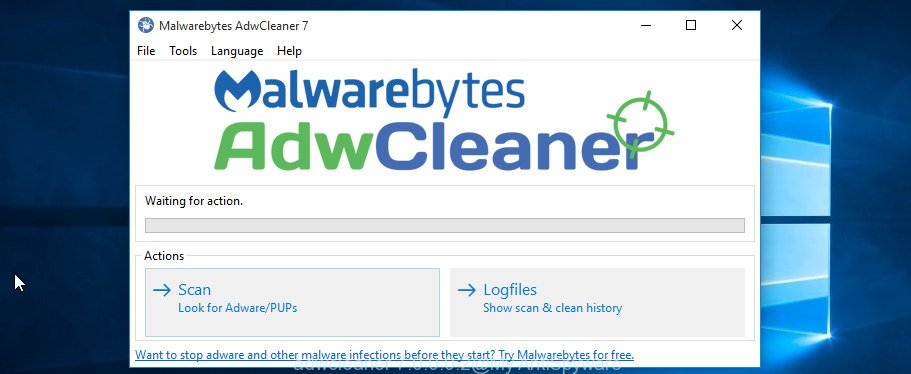
Further, click “Scan” button to perform a system scan with this utility for the Local Weather Radar hijacker and other internet browser’s malicious add-ons. This task can take some time, so please be patient. Once AdwCleaner completes the scan, AdwCleaner will show you the results as shown on the screen below.
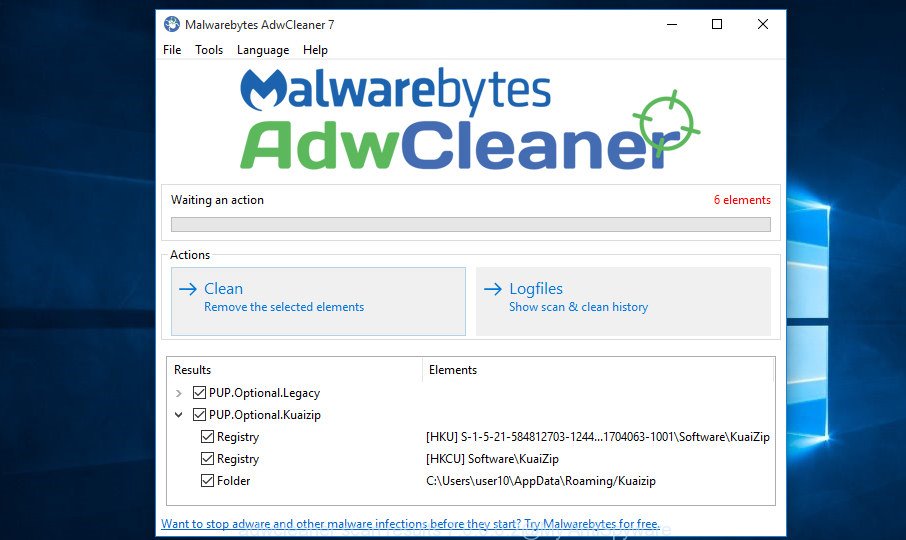
All found items will be marked. You can remove them all by simply click “Clean” button. It will open a prompt as displayed in the following example.
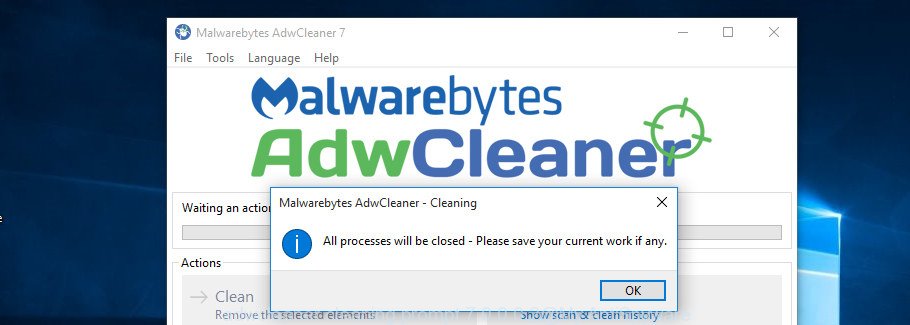
You need to click “OK”. After finished, the AdwCleaner may ask you to restart your PC system. When your computer is started, you will see an AdwCleaner log.
These steps are shown in detail in the following video guide.
Stop Local Weather Radar redirect and other unwanted web-pages
Using an adblocker program such as AdGuard is an effective way to alleviate the risks. Additionally, ad blocker software will also protect you from malicious ads and web pages, and, of course, block redirection chain to Local Weather Radar and similar web-sites.
Installing the AdGuard adblocker program is simple. First you will need to download AdGuard on your computer from the following link.
26842 downloads
Version: 6.4
Author: © Adguard
Category: Security tools
Update: November 15, 2018
Once downloading is finished, double-click the downloaded file to run it. The “Setup Wizard” window will show up on the computer screen as shown below.

Follow the prompts. AdGuard will then be installed and an icon will be placed on your desktop. A window will show up asking you to confirm that you want to see a quick tutorial as displayed below.

Press “Skip” button to close the window and use the default settings, or click “Get Started” to see an quick guide that will assist you get to know AdGuard better.
Each time, when you launch your computer, AdGuard will start automatically and block pop up ads, Local Weather Radar redirect, as well as other malicious or misleading web-sites. For an overview of all the features of the program, or to change its settings you can simply double-click on the AdGuard icon, that may be found on your desktop.
How did you get infected with Local Weather Radar hijacker
The Local Weather Radar browser hijacker infection come together with various free software. This means that you need to be very careful when installing software downloaded from the Internet, even from a large proven hosting. Be sure to read the Terms of Use and the Software license, select only the Manual, Advanced or Custom install method, switch off all additional modules and applications are offered to install.
Finish words
Once you’ve finished the step-by-step instructions outlined above, your machine should be clean from hijacker which changes browser settings to replace your home page, newtab page and default search provider with Local Weather Radar page and other malware. The Chrome, Internet Explorer, Firefox and Edge will no longer display unwanted Local Weather Radar startpage on startup. Unfortunately, if the few simple steps does not help you, then you have caught a new hijacker, and then the best way – ask for help in our Spyware/Malware removal forum.


















